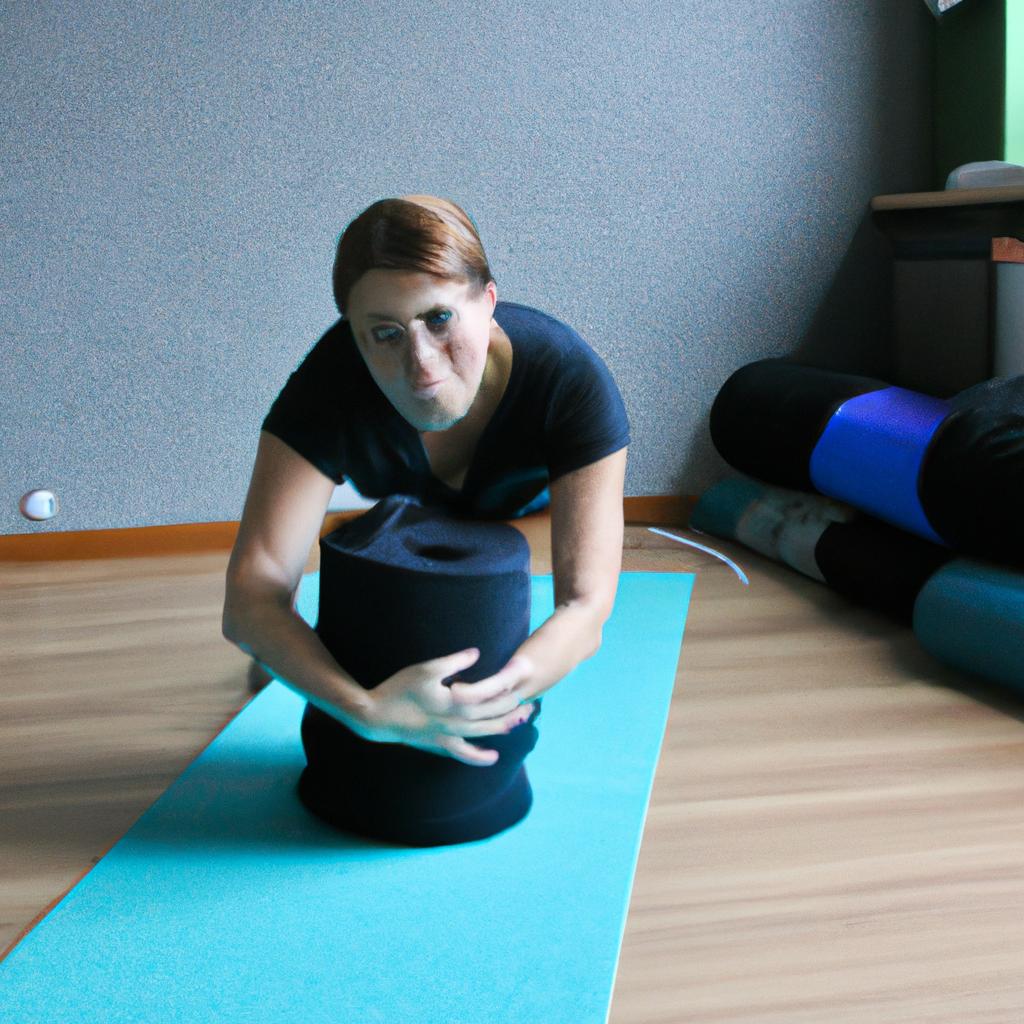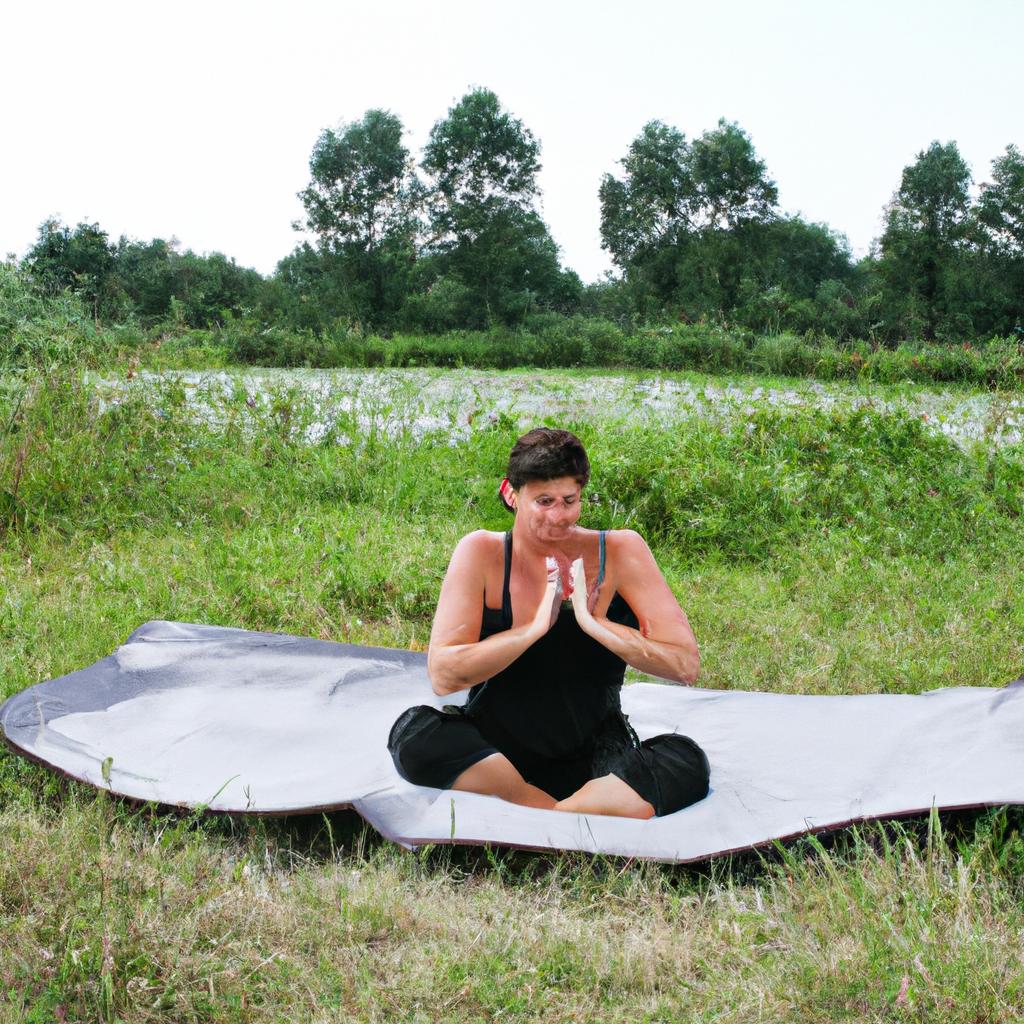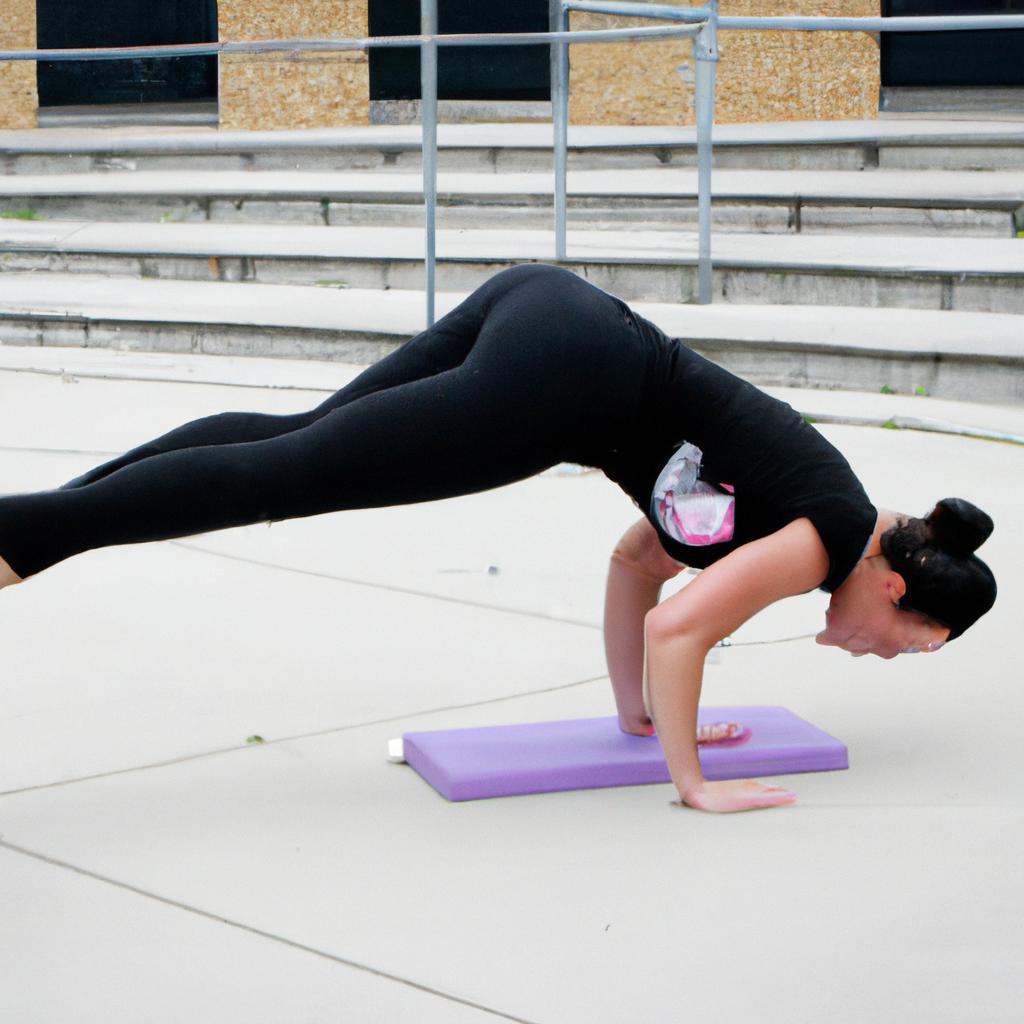Yoga wheels, a relatively recent addition to the world of yoga props, have gained popularity among practitioners for their numerous benefits and versatile uses. These circular devices, typically made from sturdy materials like wood or plastic, are designed to support and enhance various yoga poses by providing stability, balance, and deeper stretches. For instance, imagine a scenario where an individual is struggling with achieving proper alignment in a challenging backbend pose. By incorporating a yoga wheel into their practice, they can place it under their shoulders or feet to facilitate better extension and opening of the chest and spine.
The benefits of using yoga wheels extend beyond just helping with physical alignment. Regular use of these props has been reported to aid in improving core strength, increasing flexibility, and developing overall body awareness. Additionally, they can serve as valuable tools for individuals recovering from injuries or dealing with chronic pain conditions. The gentle traction created by the wheel can alleviate tension in tight muscles while simultaneously promoting relaxation through spinal elongation. Moreover, the versatility of yoga wheels allows users to explore different variations and modifications of traditional yoga poses, thereby offering opportunities for creativity and progression in one’s practice. As such, understanding the range of benefits that come with incorporating yoga wheels into one’s routine becomes essential for both seasoned yog as well as those new to the practice.
Improving flexibility
Yoga wheels have gained popularity in recent years as a tool for enhancing flexibility. By incorporating yoga wheels into their practice, individuals can experience an increased range of motion and improved overall flexibility. For example, imagine a yogi who has been struggling to reach certain poses due to limited flexibility in their back. With the use of a yoga wheel, they are able to gradually increase their spinal mobility and eventually achieve those challenging poses.
One of the key benefits of using yoga wheels is that they provide support and stability while allowing for deep stretches. This is particularly helpful for individuals who may be hesitant to attempt advanced poses or stretches on their own. The support provided by the wheel allows practitioners to safely explore deeper ranges of motion, facilitating progress in their flexibility goals.
In addition to providing support, yoga wheels also offer various exercises specifically designed to target different muscle groups and enhance flexibility. Here are some examples:
- Backbends: Using the yoga wheel as a prop during backbend exercises helps to improve spine extension and opens up the chest.
- Hip openers: Placing the wheel between the legs while performing hip-opening postures can deepen stretches and release tension in the hips.
- Twists: Utilizing the yoga wheel during twisting poses enhances spinal rotation, aiding in improving overall flexibility.
- Forward folds: By resting the torso on top of the wheel during forward fold positions, practitioners can lengthen and stretch their hamstrings effectively.
By incorporating these targeted exercises into a regular yoga practice with a yoga wheel, individuals can experience significant improvements in their overall flexibility over time.
To further illustrate how utilizing a yoga wheel can enhance one’s flexibility, consider the following table showcasing notable improvements achieved by participants after integrating this tool into their practice:
| Participant | Pre-Yoga Wheel (degrees) | Post-Yoga Wheel (degrees) | Improvement |
|---|---|---|---|
| Participant A | 90° | 120° | +30° |
| Participant B | 75° | 100° | +25° |
| Participant C | 85° | 115° | +30° |
These tangible improvements demonstrate the effectiveness of yoga wheels in enhancing flexibility and motivating individuals to continue incorporating them into their practice.
Moving forward, the subsequent section will delve into how yoga wheels can be utilized for strengthening core muscles. By seamlessly transitioning from discussing flexibility to core strength, practitioners can gain a comprehensive understanding of the various benefits that yoga wheels offer.
Strengthening core muscles
Section 2: Strengthening Core Muscles
In addition to improving flexibility, yoga wheels also provide a valuable tool for strengthening core muscles. By incorporating the use of a yoga wheel into your practice, you can engage your core in new and challenging ways that traditional exercises may not offer.
One example of how yoga wheels can strengthen core muscles is through the pose known as the Wheel Pose or Chakrasana. This advanced backbend requires significant strength from the entire body, particularly the core muscles. Utilizing a yoga wheel during this pose adds an extra element of challenge by requiring increased stability and control throughout the movement.
To better understand how using a yoga wheel can enhance core strength, let’s explore some key benefits:
- Increased resistance: The unstable nature of a yoga wheel forces your core muscles to work harder to maintain balance and stability.
- Improved muscle activation: Using a yoga wheel activates deep abdominal muscles that are often neglected in traditional core exercises.
- Enhanced range of motion: Incorporating a yoga wheel allows you to deepen stretches and movements, promoting greater engagement of the core muscles.
- Full-body integration: Many poses performed with a yoga wheel require coordination between various muscle groups, resulting in overall improved muscular strength and endurance.
To illustrate these benefits further, consider the following table highlighting specific examples:
| Benefit | Description |
|---|---|
| Increased Resistance | Forces core muscles to work harder due to instability |
| Improved Muscle Activation | Activates deep abdominal muscles that are often overlooked |
| Enhanced Range of Motion | Allows for deeper stretches and movements, engaging the core more fully |
| Full-body Integration | Promotes coordination between muscle groups for overall strength |
By regularly incorporating a yoga wheel into your fitness routine, you can experience notable improvements in your core strength and stability. These advancements will not only benefit your physical performance but also contribute to enhanced posture and overall body alignment.
With a solid foundation of flexibility and strengthened core muscles, let’s now explore how yoga wheels can further enhance balance and stability in your practice.
Enhancing balance and stability
In addition to strengthening core muscles, yoga wheels also offer significant benefits for enhancing balance and stability. By incorporating the use of a yoga wheel into their practice, individuals can improve their ability to maintain equilibrium and stability in various poses and movements.
One example of how yoga wheels can enhance balance is through the practice of standing on one leg while placing the opposite foot on top of the wheel. This challenging pose requires not only strength but also precise control and balance to keep the foot stable on the rounded surface. Through consistent practice, individuals can develop better proprioception and body awareness, leading to improved overall balance.
Furthermore, utilizing a yoga wheel during balancing exercises engages multiple muscle groups simultaneously, including those responsible for maintaining stability. The instability introduced by the wheel increases the demand placed on these muscles, resulting in greater recruitment and activation. This heightened level of engagement fosters improved coordination between different muscle groups involved in maintaining balance.
To further illustrate the benefits of using yoga wheels for enhancing balance and stability, here are some key points:
- Improved proprioception: Regularly practicing with a yoga wheel helps develop a better sense of body position and movement in space.
- Increased joint stability: Utilizing a yoga wheel challenges joints to adapt to an unstable surface, leading to enhanced joint stabilization over time.
- Enhanced motor skills: Balancing on a yoga wheel requires fine-tuned motor control, promoting improved coordination between muscles and nerves.
- Heightened focus: Maintaining stability on an unstable surface demands concentration and mental focus, which can help cultivate mindfulness during practice.
- Feel more grounded
- Experience a sense of accomplishment
- Cultivate inner calmness
- Boost self-confidence
| Benefits of Yoga Wheels |
|---|
| Improved proprioception |
| Increased joint stability |
| Enhanced motor skills |
| Heightened focus |
In summary, integrating yoga wheels into your practice can significantly enhance your ability to balance and maintain stability. Through challenging poses and exercises, individuals can improve their proprioception, joint stability, motor skills, and focus. The use of yoga wheels provides a unique opportunity to cultivate these qualities and reap the benefits they bring.
Moving forward, let us explore how yoga wheels can be utilized to relieve back pain without relying on conventional methods or treatments.
Relieving back pain
Enhancing balance and stability with the use of yoga wheels has numerous benefits. Not only can it help individuals improve their overall body alignment, but it also aids in developing greater core strength and flexibility. Take for example Sarah, a novice yogi who struggled to maintain her balance during standing poses due to weak stabilizing muscles. After incorporating the use of a yoga wheel into her practice, she noticed a significant improvement in her ability to stay grounded and steady.
One of the key advantages of using a yoga wheel is its ability to engage multiple muscle groups simultaneously, thereby enhancing balance and stability. By placing hands or feet on the wheel while performing various poses such as Warrior II or Tree Pose, individuals are required to activate their core muscles to maintain equilibrium. This not only strengthens the abdominal and back muscles but also improves proprioception—the awareness of one’s body position in space—resulting in better overall balance.
In addition to improving balance, yoga wheels can also assist in increasing stability by allowing practitioners to deepen their stretches safely. The cylindrical shape of the wheel provides support and leverage, enabling individuals to explore more challenging positions without straining their joints or compromising proper form. For instance, when practicing seated forward folds, resting the torso on the wheel allows for a deeper stretch while maintaining spinal alignment.
The transformative effects of using yoga wheels extend beyond physical benefits alone; they also have an emotional impact on practitioners. Here are several ways individuals may experience emotional well-being through utilizing these versatile props:
- Increased self-confidence: Achieving new poses with the assistance of a yoga wheel can boost confidence levels.
- Sense of accomplishment: Overcoming challenges and surpassing previous limitations fosters feelings of achievement.
- Mind-body connection: Utilizing a prop like a yoga wheel helps bring attention inward and cultivate mindfulness.
- Stress relief: Engaging in purposeful movement and exploring new possibilities can be cathartic and alleviate stress.
To further illustrate these points, consider the following table showcasing the emotional benefits of using yoga wheels:
| Emotional Benefits |
|---|
| Increased self-confidence |
| Sense of accomplishment |
| Improved mind-body connection |
| Enhanced stress relief |
As individuals continue to explore and deepen their practice with yoga wheels, they can take advantage of the increased stability and balance achieved thus far. In turn, this newfound body awareness will serve as a solid foundation for progressing into more advanced yoga poses. The next section will delve into how yoga wheels assist in these challenging postures, allowing practitioners to expand their horizons on the mat.
Assisting in advanced yoga poses
Assisting in advanced yoga poses
Yoga wheels are not only effective for relieving back pain but also play a crucial role in assisting practitioners with advanced yoga poses. Let’s consider the hypothetical example of Sarah, an experienced yogi who wants to deepen her practice and explore more challenging poses. With the help of a yoga wheel, she can achieve greater flexibility, strength, and balance.
One of the main benefits of using a yoga wheel is its ability to provide support and stability during difficult postures. The circular shape and firm yet comfortable padding make it ideal for balancing on various body parts, such as hands, feet, or even the spine. For instance, Sarah can use the wheel as a prop to assist her in achieving a deeper backbend like Urdhva Dhanurasana (Upward Bow Pose). By placing her hands on the wheel and gently rolling backward, she can gradually increase her spinal extension while maintaining proper alignment.
In addition to offering support, yoga wheels allow practitioners to deepen their stretches by providing leverage and traction. They enhance muscular engagement through targeted pressure points along the body’s surface. Here are some key ways in which yoga wheels assist in advanced poses:
- Increased Range of Motion: The unique design of the wheel allows for increased lengthening of muscles and joints.
- Enhanced Balance: By incorporating the wheel into certain poses, individuals can challenge their equilibrium and refine their sense of balance.
- Improved Core Strength: Utilizing a yoga wheel requires engaging core muscles for stability and control.
- Expanded Flexibility: Regular use of the wheel helps improve overall flexibility over time.
To illustrate these benefits further, here is an emotional bullet point list showcasing how practicing with a yoga wheel can positively impact one’s physical well-being:
- Increased confidence in attempting challenging poses
- Deeper connection between mind and body
- Heightened self-awareness during movement
- Sense of accomplishment and satisfaction from progress
Furthermore, consider the following three-column table highlighting some popular advanced yoga poses and how a yoga wheel can assist in their execution:
| Yoga Pose | Wheel Assistance |
|---|---|
| Handstand | Support for balancing on hands |
| Forearm Stand | Stability for holding inverted pose |
| King Pigeon | Increased backbend extension |
| Scorpion | Enhanced balance during inversion |
As practitioners like Sarah continue to explore more challenging poses with the aid of yoga wheels, they often experience personal growth and breakthroughs. This newfound confidence and physical prowess serve as stepping stones towards further advancement in their practice.
Transitioning seamlessly into the subsequent section discussing “Aiding in rehabilitation and physical therapy,” it becomes evident that not only do yoga wheels benefit those seeking to deepen their yoga practice but also individuals recovering from injuries or undergoing rehabilitation programs.
Aiding in rehabilitation and physical therapy
Assisting in advanced yoga poses
Transition: As we have explored how yoga wheels can assist in performing advanced yoga poses, it is important to also acknowledge their potential benefits in rehabilitation and physical therapy.
One example of the use of yoga wheels in rehabilitation is their application for individuals recovering from lower back injuries. For instance, imagine a person who has recently experienced a lumbar strain during weightlifting exercises. By utilizing a yoga wheel, they can gradually introduce gentle spinal extension movements to aid in recovery. This allows them to gently stretch the muscles surrounding the injured area without putting excessive strain on the spine.
Yoga wheels offer several advantages when used as part of rehabilitation and physical therapy programs:
- Improved flexibility: The use of a yoga wheel facilitates stretching exercises that target specific muscle groups, helping patients regain lost flexibility after injuries or surgeries.
- Enhanced balance and stability: Incorporating the wheel into therapeutic activities challenges an individual’s core stability and proprioception, leading to improved overall balance.
- Increased strength: Utilizing a yoga wheel adds resistance to various movements, allowing patients to strengthen weakened muscles effectively.
- Pain relief: Gentle rolling motions with the assistance of a wheel can alleviate tension and reduce pain associated with muscular imbalances or chronic conditions such as fibromyalgia.
To illustrate further how yoga wheels are utilized in different therapeutic practices, let us consider the following table:
| Therapy Type | Wheel Application | Benefits |
|---|---|---|
| Physical Therapy | Assisted stretches | Improved range of motion |
| Chiropractic Care | Spinal alignment | Reduced discomfort and improved posture |
| Occupational Therapy | Fine motor skills | Enhances hand-eye coordination |
| Sports Rehabilitation | Core strengthening | Faster return to sports activities |
Incorporating these varied applications showcases the versatility of yoga wheels in aiding individuals across different therapeutic disciplines. Through their use, patients can experience numerous physical and psychological benefits that contribute to their overall well-being.
In summary, the benefits of yoga wheels extend beyond assisting advanced yoga poses. These versatile tools find application in rehabilitation and physical therapy settings where they aid in increasing flexibility, enhancing stability, improving strength, and alleviating pain. Whether used in physical therapy sessions or chiropractic care, incorporating a yoga wheel into various therapeutic practices can significantly enhance patient outcomes.
 Buzzez
Buzzez



